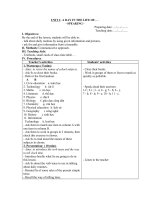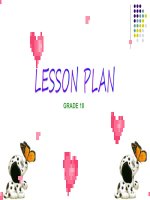a day in the life of a circus clown
Bạn đang xem bản rút gọn của tài liệu. Xem và tải ngay bản đầy đủ của tài liệu tại đây (30.88 MB, 34 trang )
A
DAY IN THE
LIFE
OF
A
Circus
Clown
;
A DAY
IN
TI{E
LIFE
OF A
Circus
Clown
by
Corol
Goskin
Photogrophy
by
Johrn F.
Klein
Troll
AssociCes
IibardW$ Caalogi1gdl tublb&n
hrt
GuLh,
Cel.
A day
ir tbc
lift
of r cim dm.
Sunmry:
Follou e ciru dm rbrcugh hir dey u
hc
pmie
mtiu, w 6r ocw ud
prcpo,
rDDlid D*c-uD. md cntcrtrinr thc eudicne.
"
l.
Cbwlluvoilc litcntun.
ll. Cloro
2. Gqb, Oru. 3. Cimr. {. OadDrtioDrl I. KIeiD,
Jobn
F. (fohn
Prcdoil), 195{t' ill. tr. fitlc.
GV!828.G37
1908
79r.33 87-t(D54
ISBN 0.8167.t107{l
(ib.
bdg.)
ISBN G8167-ll0&9
(pbt.)
Copyright
@ f988
by
Ttoll Associates, Mahwah,
New
Jersey.
All
rights
reser'ti/ed. No
part
of this
book
may be used or
reproduced in
any manner ryhatsoever
without written
permission
from the
publisher.
Printed in
the United States of
America.
10987664321
The author
and
publisher
wish to thank the stafr of
Allan
C.
Hill Entertain-
ment
Corp., especi8lly Allar C. Hill,
trYed
John, and Jefirey Scott;
Mike
Ri-
denour, Jim Ridenour,
and the
per{omers
and stafiof Grest
American
Circus,
Special
thsnks to
Charleg
Neubauer
of Sa,resota,
Floride.
Photograph
on
page
5
by
Fled
John, courteey ofAllan
C.
Hill Entertainment
Corp.
fr**.lr*ru
Mike Ridenour
is
a clown
in a traveling circus.
Every morning
he wakes up
in
a
new town.
Dur-
ing
the
night,
the circus
travels
in
a caravan,
or
long
line of trucks
and
trailers.
The
trucks
arrive
at
an empty
field
at dawn.
By midday, the circus
will spring to life
once again.
fl.wffiffry-$ffi
3
As
the
sun
rises, workers called
"roustabouts"
raise
the Big Top. The tent will cover two-thirds
the area of a
football field. First, tent stakes are
driven
into
the
ground
and tent
poles
are
laid
out.
Then
the tent
is
unrolled
from a special truck,
called
a
"spool
wagon."
4
The roustabouts
spread the
canvas over
the
metal
poles
that will support the
roof.
They anchor the
sides of the tent
to
the wooden tent
stakes.
Later,
when the
heavy
tent
poles
are
raised, the
tent will
go
up with
them.
To
do this,
very special
equip-
ment
will be
needed-elephants!
5
The
elephants are harnessed to the
poles.
They
pull,
and
up
goes
the tent!
Circus
tents
have
been
raised
this
way
for
generations.
When
it rains,
elephants
are also used
to
pull
trucks and trailers
out
of the
mud.
So
many circus vehicles
get
stuck
that traveling
circuses are often called
"mud-
shows."
6
't
I
t
f
f
,
t
f
Mike has free
time
while
the tent
goes
up.
He
practices
an acrobatic routine
with
Chepi, a seven-
year-old
clown. Most
clowns learn
their trade
from
older clowns.
Mike's first
teacher was his
father. Now
Chepi, whose
parents
are
bareback
riders in
the circus,
learns
clowning
from
Mike.
It's
a circus tradition.
I
.;,
Mike
washes in
cold water
from a huge water
truck. He
naps in the shade of another
truck. Cir-
cus
life
is not
always comfortable!
The circus
is
like
a town
on wheels.
The
performers ride, wash,
eat
and sleep in
the
eighteen-wheelers
that
have
replaced
the circus wagons of
the old
days.
8
Being
a clown is not
all clowning.
Mike
must care
for his
costumes
and
props.
He
grooms
his
clown
wig
and
practices
on a miniature trumpet
he some-
times uses
in
his
act.
Some
days
he
works
on
his
juggling
or stilt-walking. His
act
is
always
chang-
ing
as
he masters
new
skills.
9
An
hour
before
showtime,
Mike
applies his make-
up,
or
"puts
on his face."
First he
coats his face
with
white
grease
paint.
He
smiles
and
frowns
to
study
the
creases
and hollows
his facial muscles
make.
Then
he
outlines spaces
where
he
will
wipe
the
white
grease
paint
away.
10
Mike
fills in
the spaces with flesh color. There are
several
classic clown types: the
neat
whiteface,
the unshaven tramp, and the colorful
Auguste.
Mike is
an
Auguste-type
clown.
An Auguste
clown
has
a
flesh-toned
face
and
wears
bright, baggy
clothes.
The
jokes
are
always
played
on him.
$
-&
;&
'$h,
$
uts
d$;
.o
,#,,"t
dfi
ffi*
11
A
clown's face is
as
personal
as his signature.
Mike
adds
the detailing that makes his face his
own. He
paints
his
cheeks
cherry
red
and adds touches
of
black
to
his
eyes
and
mouth.
Soon
he
will assume
his
clown
personality,
a
goofy
character named
Omar
Gosh.
t2
Mike
fills
an
old sock with baby
powder
and
pow-
ders
his face.
"Don't
you
wonder
what
happens to
all
of those socks
you
lose?"
he
asks.
"They
travel
all over
the world.
Clowns
have
them!"
Finally, to
"fix"
his face, Mike
blots the
excess
powder
for
a
smooth
finish.
13
Mike
dresses
in
the
costume
he has
picked
for
the
day. He
always
wears
baggy
pants,
suspenders,
and
a loud
shirt. He
finds
some of his
costumes
in
second-hand
stores.
His
giant-sized
clown
shoes
come
from
a
mail-order
company.
Mike
wears
out
two
pairs
every
season.
#'e-
L4
As
Mike
adds
the
finishing
touches, he
says,
"When
most kids
think of
a clown,
they think
of
great
big
shoes
and a
red
nose."
Omar
Gosh al-
ways has
both. He
puts
on a bright false nose,
a
silly little
hat,
a
big smile,
and
Prestol
Say
"hello"
to
Omar
Gosh!
15
-s#
"Px;
"r-[.
i,\
idt{',,:.'lil,,
{
ifF'ry
';ft
h-
It's
showtime! The audience streams toward
the
entrance to the
Big Top. They must
walk
along the
"midway"-v
broad avenue
lined with rides and
concession stands.
The
air smells of circus
ani-
mals,
peanuts,
and
cotton candy.
Inside
the
Big
Top,
the
music
starts, and
peoplebuzzwith
excite-
ment.
16
The ringmaster
blows
his
whistle and introduces
the first
act.
"Ladies
and
Gentlemen,
Boys
and
Girls,"
he
announces.
"Presenting-that
juggling
genius,
Jose
Torres!" It's
the
ringmaster's
job
to
make
sure each act is ready
on time, and to
see
that the show flows
smoothly.
t7
Animal
acts
are
the heart
of the
circus, and
animal
trainers
are highly
respected.
The
audience
oohs
and aahs
as acrobats
ride
trick
ponies,
elephants
dance,
and fearless
trainers
work with ferocious
jungle
cats. But
if
animals
are the heart
of
the cir-
cus,
clowns
are its
soul.
18
The
clowns
do an old
routine
called
"Queen
Bee."
"Hey,
Coco," says Omar Gosh,
"glve
me something
sweet!"
Coco
replies,
"How
about some honey?"
Omar
exclaims,
"Oh,
I love honey!"
Then
Coco
buzzes around the ring,
saying,
"I'm
the worker
bee,
collecting honey for
the
queen
bee!"
19
Coco says,
"When
you
say
'Let
it fly!' I'll
give
you
the honey." But
when
Omar
isn't looking,
Coco se-
cretly fills his
mouth
with water. Omar says,
"Yum,
honey!
Let it fly!" The
crowd explodes with
laughter
as the
"honey"
splashes
in
Omar's
face!
20
Omar decides
to
play
the
same trick on
Little
Dave.
"I'll
be the worker
bee,"
he
says.
But he
trips
and
loses
his
"honey."
While
Omar
gets
a
re-
fill,
Little
Dave
sneaks a mouthful too.
When
Little
Dave
doesn't say anything,
Omar
swallows
his
"honey"
and cries,
"You're
supposed to say,
'Let
it fly!"'
\
2l
Little Dave
"lets
it
fly"
and Omar Gosh
gets
show-
ered again. The crowd
roars.
Omar
is
used to
being the
one
who always
"gets
it." It's
his
tradi-
tional role.
"Making
people
laugh is what being a
clown
is
all about,"
he
says.
And he
always
gets
a
laugh.
22
After
changing
into
a dry costume,
Omar
sells col-
oring books
in
the stands. It
is
an
important
part
of
his
job
with
the circus because
it
allows
him
to
get
closer
to the audience. He
can
joke
with the
children, shake their
hands,
and autograph
their
souvenir books.
23
Between
shows,
Omar works
on the
midway.
To
help
advertise
the circus, he
gives
an interview
to
a
disc
jockey
from
a local radio
station. Then
he
greets
the
children
on the
train
ride,
who
are
thrilled
to meet
a real
clown. Promoting
good
pub-
lic
relations
is
a serious responsibility
for
a circus
clown.
24









